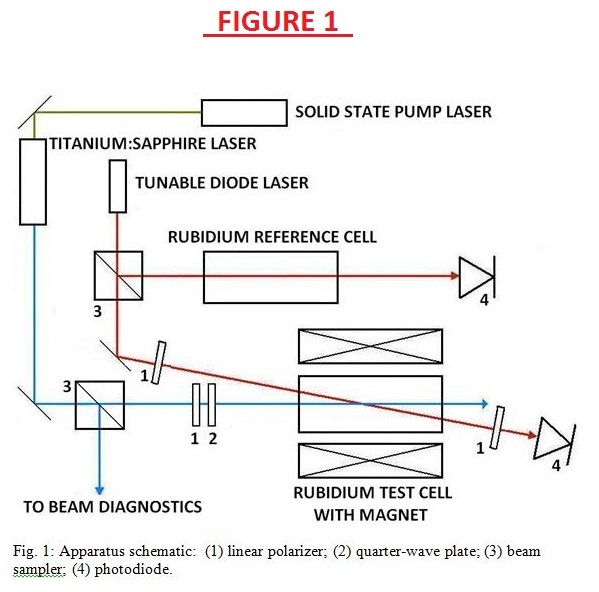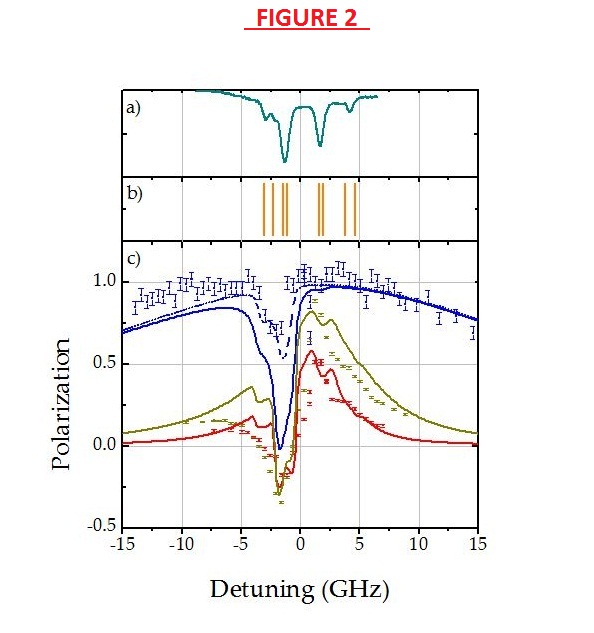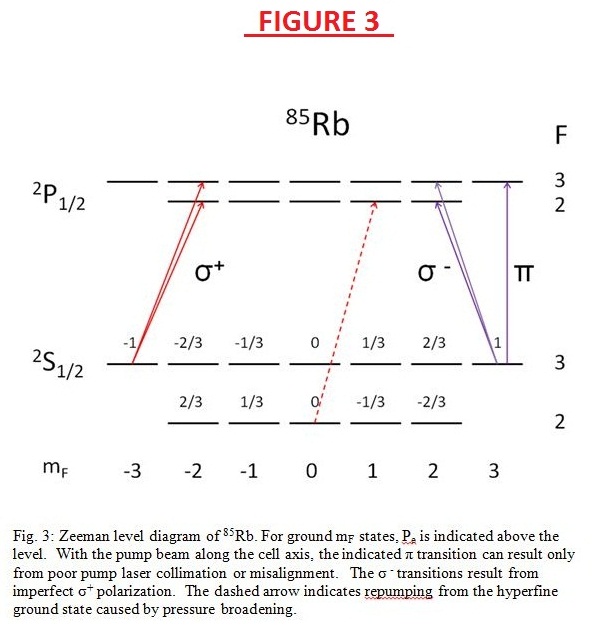Archives
Optical Pumping of Mixtures of Rb vapor and N2 Buffer Gas
|
Using the experimental setup shown in Fig. 1, we have studied the optical pumping of mixtures of Rb vapor and N2 buffer gas. As the frequency of the right-hand circularly-polarized (σ+) laser is varied across the D1 absorption profile, the electron spin polarization of the Rb, Pe, is found to take on negative values for small negative values of pump detuning from the absorption profile center (see Fig. 2). The spin reversal phenomenon is due to the underlying hyperfine structure of the optically-pumped Rb vapor. This can be understood by considering the Zeeman structure of 85Rb (Fig. 3). When F < I+J, the expectation value of Pe for a given eigenstate of the hyperfine Hamiltonian is proportional to -mF. Thus, for 85Rb, if one could selectively populate the 2S1/2 F = 2 state with mF > 0, the polarization of the hyperfine-averaged J-states of the atom would exhibit Pe < 0. To achieve this by pumping the F = 3 --> F = (2,3) transition, however, requires a non-σ+ component of the pump laser polarization that can drive vertical or left-going absorptions in order to eliminate population of the F = 3, mF = +3 dark state. 
|
 Fig. 2: a) Absorption scan of probe in Rb reference cell. b) Positions of hyperfine transitions, from left to right: 87Rb Fg = 2 → Fe = 1, 87Rb 2 → 2, 85Rb 3 → 2, 85Rb 3 → 3, 85Rb 2 → 2, 85Rb 2 → 3, 87Rb 1 → 1, 87Rb 1 → 2. c) Measured and calculated polarization of Rb vapor as a function of pump laser frequency. Blue data: 10 Torr N2, 4.3 • 1012 cm-3 Rb; solid curve: 10 Torr N2, 99.5% light polarization; dashed curve: 10 Torr N2, 99.95% light polarization. Green data: 1.0 Torr N2 and 8.8 • 1012 cm-3 Rb; curve: 1.0 Torr N2 and 99.5% light polarization. Red data: 0.1 Torr N2, 8.4 • 1012 cm-3 Rb density; curve: 0.1 Torr, 99.5% light polarization.
Fig. 2: a) Absorption scan of probe in Rb reference cell. b) Positions of hyperfine transitions, from left to right: 87Rb Fg = 2 → Fe = 1, 87Rb 2 → 2, 85Rb 3 → 2, 85Rb 3 → 3, 85Rb 2 → 2, 85Rb 2 → 3, 87Rb 1 → 1, 87Rb 1 → 2. c) Measured and calculated polarization of Rb vapor as a function of pump laser frequency. Blue data: 10 Torr N2, 4.3 • 1012 cm-3 Rb; solid curve: 10 Torr N2, 99.5% light polarization; dashed curve: 10 Torr N2, 99.95% light polarization. Green data: 1.0 Torr N2 and 8.8 • 1012 cm-3 Rb; curve: 1.0 Torr N2 and 99.5% light polarization. Red data: 0.1 Torr N2, 8.4 • 1012 cm-3 Rb density; curve: 0.1 Torr, 99.5% light polarization.
We have modeled these effects with rate equations for the individual F, mF ground- and excited-state sublevels for 85Rb and 87Rb. The predictions of the model are depicted as the solid-line curves in Fig. 2c with the fit parameters of laser power 100 mW and the fraction of left-hand circularly-polarized (σ -) light is 0.5%. The model gives reasonable agreement with the data. The dashed-line curve shows the results for 10 Torr with the fraction of σ - light equal to 0.05%. As the data sets were taken on different days, the waveplate may have been set slightly differently for the 10 Torr data set or experienced a small rotation around the vertical axis, which would yield different polarizations at the respective optimal settings. 
|
|
Joan Dreiling, Jorgensen Laboratory of Physics Archived: January 2020 |
